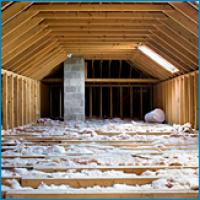
Save Energy in Your Attic With These Solutions
Find Out Where YOUR Home is Losing Energy:
If you have trouble keeping your home cool in the summer and warm in the winter, a good place to start is in the attic. Air leaks and insufficient insulation in the attic can cause uncomfortable conditions in your home, and are common sources of energy loss. With some simple air sealing and insulation, you can remedy these problems to save energy, save money and enjoy your home more.
Seal Air Leaks to Save Energy
You can seal air leaks in your attic - and on exterior walls of your home - using caulk, spray foam or rigid foam insulation to fill holes, cracks and gaps. You'll help reduce drafts and get better performance from your insulation, which help you save energy. For best performance, always seal air leaks before adding insulation. For more information on sealing and insulation, see ENERGY STAR's Guide to Home Sealing (2MB).
-
Prevent Heat Transfer - Seal Holes in Attic Floor
A lot of equipment penetrates into your attic, such as ducts, vents, electrical wiring, plumbing pipes and recessed lighting from the ceiling below. There are often holes or gaps around these penetrations which allow warm air from your home to escape through the attic in winter, making your heating source work harder and wasting energy as a result. The reverse is also true in summer, where hot air in your attic leeches into your home through these holes, making your air conditioner work overtime, costing you extra money to keep your home cool. You can prevent this by sealing the holes. For small gaps and cracks, you can use caulk. For holes up to 3 inches in diameter, use spray foam. For gaps that are bigger than 3 inches, cover the gap with foam board then seal it with spray foam.
-
Chimneys or Furnace Flues Get Hot
Just like the equipment discussed above, chimneys or furnace flues that penetrate into your attic can have spaces around them that cause drafts and energy loss. But chimneys and furnace flues can get hot so they're treated differently. For larger gaps, cover with metal flashing and seal in place with high temperature caulk. For smaller gaps and cracks, simply seal them with high temperature caulk.
-
Attic Hatch/Door - Big Culprit for Energy Loss
Many people don't realize that the door or hatch leading to the attic is a major source of energy loss. Make sure the hatch or door to your attic is well insulated and has weather-stripping to prevent excessive heat transfer.
Insulate After Air Sealing for Maximum Efficiency
After all the air sealing is completed, it's time to add insulation (if necessary). If you can see the tops of your attic's floor joists (i.e. they're not covered by insulation), then adding insulation will can help you lower your energy bills even more. To get the best performance from insulation, it's extremely important to seal air leaks BEFORE the insulation is installed. The attic is an easy place to add insulation, and it can have a dramatic effect on your comfort and energy bills. » Insulation Facts from The Department of Energy
Sealed Ducts are More Energy Efficient
Ducts often have gaps or seams where conditioned air leaks out, making your system work harder to achieve desired results. You can reduce leaks and improve energy effiicency by sealing loose connections and seams with mastic or foil-backed tape. Where ducts run through unconditioned areas like attics, crawl spaces and basements, wrap them in insulation or cover the ducts with blown insulation. » Learn More About Duct Sealing from ENERGY STAR.
Proper Attic Ventilation Saves Energy
You can ventilate your attic with natural air flow to keep the roof deck cool and dry, without using energy to run an attic vent fan. Proper ventilation extends the life of roof shingles and prevents ice dams. Make sure soffit and gable vents aren't blocked so air can flow through. Learn more about attic ventilation in ENERGY STAR's Guide to Home Sealing (2MB).
Useful Energy Efficient Solutions:
- Attic Attic Ventilation, Duct Sealing, Chimney Sealing
- Basement Retire your old refrigerator!, Dehumidifier, Water Heater
- Bathroom Vanity Lights, Light Switch, Vent Fan
- Bedroom Bed-Side Lamp, Light Switch, Room Air Conditioner
- Dining Room Light Fixture, Light Switch, Programmable Thermostat
- Heating and Cooling Systems Table Lamp, Light Switch ...
- Home Office Desk Lamp, Ducts, Electrical Outlets, Power Strip
- HVAC HVAC air conditioning. HVAC Maintenance. HVAC contractor.
- Kitchen Light Fixture, Light Switch, Floor Vents/Radiators
- Living Room Table Lamp, Ceiling Fan with Lighting, Light Switch
- Outside House A/C Unit, Porch Light, Thermal Boundary
- Energy Efficient Windows Replace or Renovate, Energy Efficient Window Treatments
We were unaware of what was involved in an energy audit and your audior took the time to explain everything. We were impressed with the report which told us the areas in which we need to take action on. He never pressured us to use any particular contractors, he just suggested that we go to the Building Energy Pros web site to select contractors of our own choice. He did an excellent job and we HIGHLY recommend the Building Energy Pros. We already have recommended them to several of our neighbors. Again, EXCELLENT JOB!
Cynthia Simpson
The Building Energy Pros auditor was very knowledgeable. I was VERY HAPPY with him. He promptly E-mailed my energy audit report to me and I will consider all of his recommendations.
Tom McGee
We found out that our house really has no energy problems. We are happy to know that we
Leslie Stewart
I was very satisfied with your energy auditor. He was very qualified and spent a great deal of time with me. The energy audit was very informative.
P.B.
The energy auditor was very good and helpful. He keeps in touch with me to answer any of my questions.
D.G.
I was very satisfied with my energy audit. The auditor gave me some tips on attic insulation that were very helpful.
R.G.
I was very satisfied with my energy audit. Thank you!
R.S.
Very good service! I am going to replace the windows as the auditor had suggested.
D.W.
I was very happy with the energy audit. THANKS!
A. M.
My energy audit was very helpful. Joe Dempsey, your auditor, identified some structural problems that I was not aware of and explained to me why I need more insulation.
J. F.
The auditor was EXCELLENT! He spent ALOT of time with me. I am going to take 3 to 4 of his suggestions and correct these small items to save on my energy bills.
M. B.
The auditor did a GREAT JOB! He knew a lot about older homes, which we have. The report was very comprehensive. Thank you!
Vicki Nez/at
Your energy auditor was very nice and helpful. He answered all of our questions. We will recommend Building Energy Pros to our friends and neighbors.
Katherine McCaffrey
The auditor did a TERRIFIC JOB! The report was FANTASTIC! I will make all the repairs he suggested. I will definitely recommend him to everyone I know that could benefit from a home energy audit.
Steve Sleigh, Chevy Chase
The energy auditor was very professional and I am very satisfied with both the energy audit and the report I received. I will be referring the Building Energy Pros.
Tim Clary
I was very satisfied with the auditor. He was great and gave me some very valuable information. I will refer him to people I know who may need a home energy audit.
Willie Gantt
Your home energy audit proved to be very informative and helpful. I was not aware of the updraft created inside our walls because of the balloon framing construction. You said that that can cause heat to be pulled out of the house with the draft going up inside the walls and should be re-mediated. You also said that the attic insulation was insufficient and that fiberglass batts can leave spaces for around the edges causing heat loss and that it should have blown in insulation on top of what was there to seal the whole attic and increase the r factor. After going over your findings and telling me how you would fix the problems you told me how I could do it myself with stuff from the Home Center and for a quarter of the cost. Well, I did. I went into the basement and filled the bottom of the wall joist with unfaced insulation where they set on the sill plate. I then cut one inch foam board the size for each space and set it in and the sealed the edges of that with expanding foam as well as the sill plate to the foundation. I also sealed the sill plate to the foundation where the joist ran along it, as well as the top of those joist where it made contact with the subflooring. Next I went to the home center and rented their blown insulation machine and got ten bales of the insulation. I filled the attic on top of the batt insulation with about six inches giving another r-19 factor on top of the r-19 that was there. You said that the blown in would also help seal the heat loss around the edges of the batt. The work in the basement cost $144.00 and the work in the attic cost $328.00. After the 30% federal energy tax credit it will end up costing me about $330.00, which you said I should recover in savings in the first year. Thank You for all your advice and expertise. You made me aware of things I should consider and did.
Tommy Thompson


